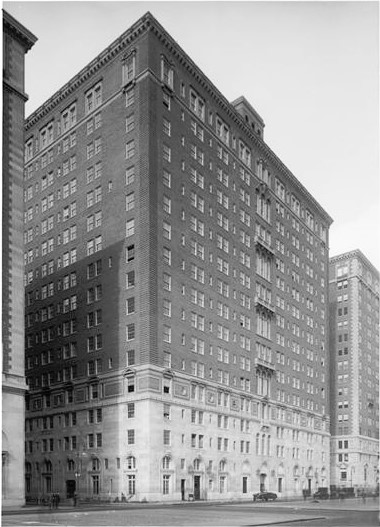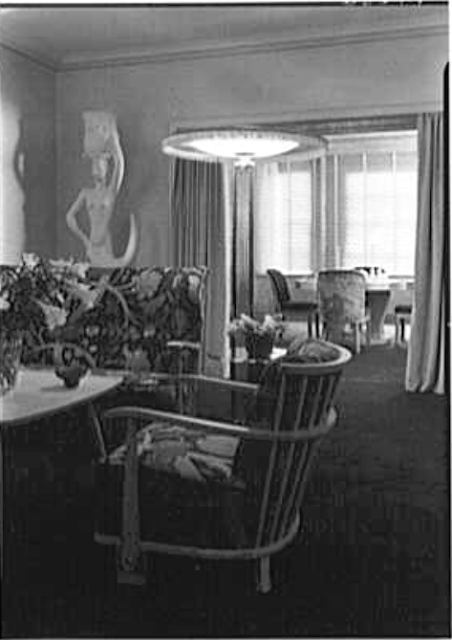photo by Wurts Bros. from the collection of the Museum of the City of New York.
On July 19, 1920, architects Warren & Wetmore filed plans "for the great $2,500,000 cooperative apartment house to be erected in the west side of Park av., between Forty-eighth and Forty-ninth sts," as reported by The Sun. Projecting that it would be the "world's biggest apartment," the article noted that while Warren & Wetmore had been hired by the 290 Park Avenue Company, "the New York Central and Harlem River Railroad Company are the owners of record."
It was a complicated arrangement. About 30 wealthy families had formed a co-op in order to erect a building with apartments to their specifications. On November 20, 1921, the New-York Tribune explained they, "own the structure from the ground floor up, and own it outright." But the New York Central owned the land and the railroad tracks over which the building would be erected. The builder of 290 Park Avenue, Fred T. Ley, paid the $450,000 necessary for the construction of the steel structure over the railroad tracks in exchange for rent on an apartment. "The cost represented about five years' rent, which was assigned to Mr. Ley by the New York Central," said the New-York Tribune.
Describing the planned building on July 20, 1920 as, "one of the finest apartment houses in the world," the New-York Tribune said, "It will be built to meet the special requirements of a number of folks who have been unable to find what they wanted in other houses and decided to build an apartment, part of which they would occupy."
The original 30 families were joined by "some of the wealthiest people in the country," according to the New-York Tribune. The New York Times explained on November 14, 1920, "About 70 per cent of the structure will be sold to individuals and 50 per cent rented." The article said, "Many of the new owners are already having plans drawn for the apartments they have purchased."
Three months before Warren & Wetmore filed plans, an advertisement in The New York Times promised:
It is to be the last word in apartment house construction. Ultra modern in every detail. More than a city residence--more than a hotel--where the hourly or double service system of domestic employment is to be inaugurated. This service solves the servant problem and includes a hotel service of the highest, but strictly private order, when desired.
As construction neared completion on March 9, 1921, the New-York Tribune reported, "Seven million dollars is involved in the operation." That figure, equal to about $119 million in 2024, was free of any mortgage. Warren & Wetmore's staid neo-Italian Renaissance design included a four-story stone base. The decorations--stone balconies and Renaissance-inspired pediments--were minimal. A distinctive corbel table ran below the cornice.
The large ground floor commercial space was leased "to Pierre, the restaurateur" in March 1921. Few New Yorkers knew that Pierre had a first or last name. Charles Pierre Casolasco was already well known among Manhattan's upper crust for his high-end cuisine and service. Pierre not only opened his first-class French restaurant in the building, but he and his wife, the former Adeline Harbord purchased an apartment here.
On October 7, 1922, Hotel Operation described Pierre's as, "the place where New York's 400 lunch and dine and dance." The restaurant's status among high society was reflected in the New-York Tribune's mentioning on October 21, 1921, "Among those who entertained at luncheon yesterday at Pierre's Restaurant, 290 Park Avenue, were Mrs. William K. Vanderbilt 2d, Mrs. Frederick T. Frelinghuysen, Mrs. August Belmont jr., Mrs. Lyttleton Fox and Foxhall P. Keene."
Saying, "All of the apartments are luxurious and designed especially for people of untold wealth," Hotel Operation said, "One floor which has a ten-room apartment on it cost to buy $100,000 and the new owner is spending another $50,000 in rebuilding it to suit himself...Another room has a paneled ceiling with hand-painted work done in each panel."
Among the earliest owners was one of its designers, Whitney Warren. Like their neighbors, he and his wife, the former Charlotte Augusta Tooker, would appear in society columns routinely. On February 10, 1922, for instance, the New York Herald announced, "Mr. and Mrs. Whitney Warren will give the second of a series of receptions with music next Tuesday night," and on September 14 that year, the New-York Tribune reported, "Mr. Whitney Warren gave a dinner at his home, 290 Park avenue, last night for Mr. and Mrs. Robert Goelet."
Paul D. Cravath and his wife, opera singer Agnes Huntington, were also early residents. A prominent corporate lawyer, Cravath was a director of the New York Symphony Society and the Juilliard School of Music. He would become chairman of the Metropolitan Opera in 1931. The couple's summer estate, Veraton, was in Locust Valley, Long Island.
On August 3, 1921, the New-York Tribune reported that James Brown "of the international banking house of Brown Bros. & Co." had purchased an apartment. Like most residents, the Browns traveled extensively. On February 2, 1923, for instance, the Chicago Daily Tribune reported, "Mr. and Mrs. James Brown of 290 Park avenue sailed for a cruise in the Mediterranean today. They will be away until May;" and on July 29, 1925, the newspaper announced, "Mr. and Mrs. James Brown...who have been spending the early part of the summer at the Bungalow, one of the Piping Rock Club cottages at Locust Valley, are planning to join the American contingent abroad and will set sail on Aug. 5."
Potential residents who chose to rent rather than buy could expect to pay up to $14,000 a year for a nine-room apartment (about $19,800 per month in 2024 terms). An advertisement noted, "A competent staff of servants under the direction of a housekeeper is available for those who desire to eliminate unnecessary burdens. An added attraction is Pierre's restaurant on the main floor from which meals may be served in the apartments."
Two views inside of the I. E. Verrando apartment. from the collection of the Library of Congress
Bessie Douglas Dearborn purchased a 15-room apartment with five baths in December 1921. Her husband, George S. Dearborn, president of the America-Hawaiian Steamship Company had died on May 29, 1920. The New York Times had described their yacht, the Colonia, as "one of the most beautiful of its class afloat."
Dr. Percival Martin Barker and his wife Alice Hearn were early residents. The couple was married on December 20, 1917. Alice's grandfather had founded the dry goods firm of James A. Hearn & Son. Tragically, just months after moving in, Alice died of pneumonia in their apartment on December 20, 1921. Her estate was formally estimated at "more than $1,000,000," according to the New-York Tribune.
Barker's grief was still fresh when he had to deal with a burglar less than three months later. The thief made off with $12,000 of Alice's jewelry (closer to $218,000 today). Miles Boucher, who was captured on March 22, 1922, was "alleged to have committed at least forty burglaries in order to finance a burlesque show," reported the New York Evening World.
Resident Caroline Graham Slaughter was the divorced wife of E. Dick Slaughter. The Texas native drew society's attention when she married William Robertson Coe in her apartment on December 5, 1926. The New York Evening Post said on December 11, "It was impossible for Mr. William Robertson Coe to marry again, without creating a flutter of interest." Coe's first wife, Mai Rogers (daughter of Standard Oil magnate Henry H. Rogers) died in 1926. The New York Times remarked, "No previous announcement of an engagement had been made, and news of the marriage came as a surprise."
Coe's estate, Planting Fields, was one of the showplaces on Long Island. The New York Times said, "On their return from the West Mr. and Mrs. Coe will live at Planting Fields, Oyster Bay. They plan to leave in January to spend four months on a Mediterranean cruise and a trip in Egypt."
A celebrated couple at 290 Park Avenue were Edward H. Sothern and his wife Julia Marlowe. The two had met in 1904 when the played opposite one another in Romeo and Juliet. The on-stage chemistry led to a long-term partnership in Shakespearean roles and, finally, to marriage. Julia Marlowe retired from the stage in 1924 due to failing health (although she survived until 1950).
In 1930 Charles Pierre Casalasco opened the 41-story, 714-room Pierre Hotel at the corner of Fifth Avenue and 61st Street and moved his famous restaurant into the building. "Helen Worden's 1932 The Real New York recalled, "Famous parties have been staged here. Debutante affairs that sometimes cost fifty thousand dollars had this spot for a background."
Now, the book noted, Pierre's former space was home to Therese Worthington Grant's. Worden called it "a nice place to take out-of-town relatives." Therese Worthington Grant's cuisine could not have been more different from Pierre's. Explaining that Grant was "born and reared in Kentucky," Worden said, "The cooking is the sort you hope to find south of the Mason and Dixon line."
Steel tycoon Charles M. Schwab and his wife, Eurana, built one of Manhattan's largest and most opulent mansions, Riverside House, in 1906. Then the Depression hit and Schwab's fortune was greatly reduced. On Christmas day 1938, Eurana suffered a heart attack and died on the morning of January 12, 1939. Early in March, Schwab closed Riverside House, sold his two country estates, and moved into 290 Park Avenue. His residency would be short-lived. The 77-year-old died of a heart attack in his apartment on September 18. About 2,000 people attended his funeral in St. Patrick's Cathedral.
The fact that the co-op owners did not own the land under the building was their undoing. No doubt to the surprise of many New Yorkers, on December 13, 1957, The New York Times reported, "The New York Central Railroad is about to lease to builders the land at 290 Park Avenue...The builders will replace the apartment house on the site with an office building." The Bankers Trust Building designed by Emery Roth & Son was erected on the site.
no permission to reuse the content of this blog has been granted to LaptrinhX.com

.jpg)




No comments:
Post a Comment